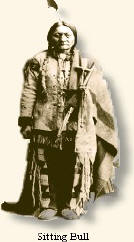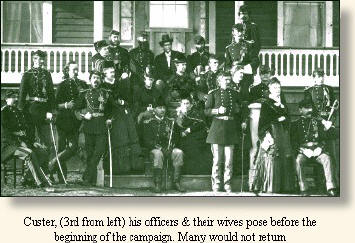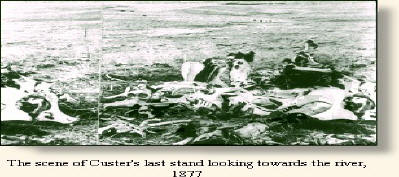|
|
||
|
|
||
| The Battle of Little Bighorn was started by the signing of the 1868 peace treaty by the Lakota Indians who agreed to stop raids against the settlers and other enemy tribes wanting to settle on their reservation. This treaty was to help relieve the cultural change for the Sioux. | ||
| Sitting Bull and Crazy Horse resisted this policy. They feared becoming too independent on the government. The non-reservation Lakota were to strengthen with new force during the summer months by the groups called assumer roamers. | ||
| In 1874 Lieutenant Colonel George Armstrong Custer was ordered to explore Black Hills in the middle of the Lakota Sioux reservation to look for future military posts. During this expedition professional geologists discovered large deposits of gold in paying quantities, and the resultant rush of entrepreneurs to Black Hills was met with violence by the Sioux, who considered the whites as unwelcome intruders on a sacred ground. | ||
| On the winter of 1875 the Commissioner of Indian Affairs required all of the non-reservation Sioux to report to a reservation by the end of January, 1876. This did not work out the way planned so matters were handed over to the military. | ||
| The campaign of 1876 caused the military to split into three columns. The first column was led by Colonel John Gibbons. The second column was led by General George Crook. The third column was led by General Alfred H. Terry and marched west from Lincoln to Bismarck, North Dakota. These columns were said to beat the 800- 1,000 warriors they were supposed to fight. | ||
| General Crook and his column found out they had drastically underestimated the number of warriors. On June 17th Crazy Horse and 1,300 to 1,500 warriors attempted to attack Crook. Crook suffered thirty casualties and the Indians suffered twenty. Crook then went to Goose Creek in northern Wyoming to wait for the supplies and reinforcements. The Indians moved west until June 23rd or 24th where they stopped at Little Bighorn. | ||
| The Indians were excited by the happenings of the Sun Dance Ceremony where Sitting Bull was said to have had a vision that the Indians would overcome a great victory. | ||
|
The Sun Dance Ceremonies were a time where all of the Indians would get together for a few weeks in the spring. At one of these ceremonies Sitting Bull sacrificed fifty pieces of flesh from each arm, and then received a vision of the future.
|
||
| The Indians did not know that Custer and the 7th Cavalry were dispatched so this came to them as a big shock. | ||
|
||
| Reno and his men charged the Indian village under Custer's command. Because of the dust and smoke Reno and his men did not see warriors coming up the hills from the village who eventually held them under siege throughout June 25th and all day June 26th. | ||
| Terry and Gibbons arrived to rescue the battled remnant of the 7th Cavalry and found all of Custer's men dead. | ||
| Custer ordered Reno to charge the village while he rode along the bluffs until Reno and his men were defeated. Before long, Custer's two battalions were driven north and killed. | ||
| Overall 210 men were killed under Custer's command. Those who tried to escape were soon to be captured by the warriors. After the battle was all over the warriors went around scalping all of the white men and making sure that they were all dead. | ||
| The Battle of Little Bighorn was also known as " Custer's last stand." | ||
|
|


 Custer
Custer
